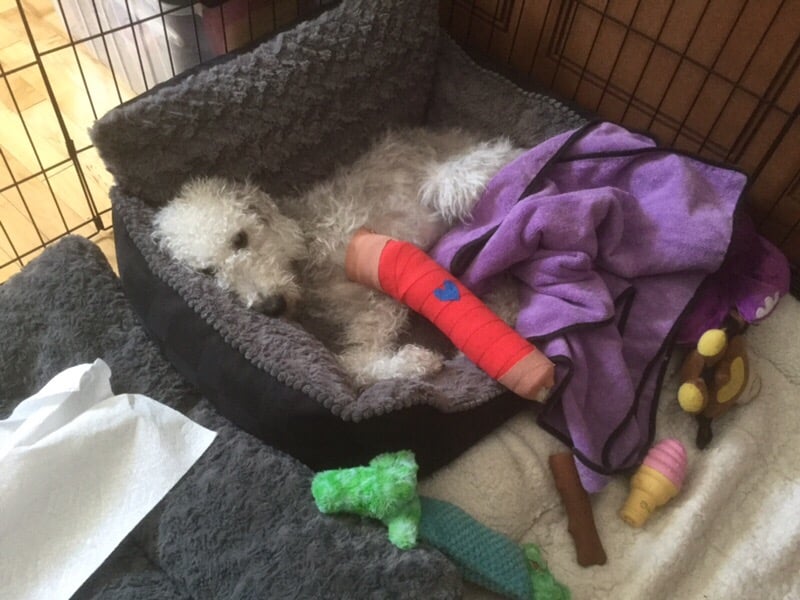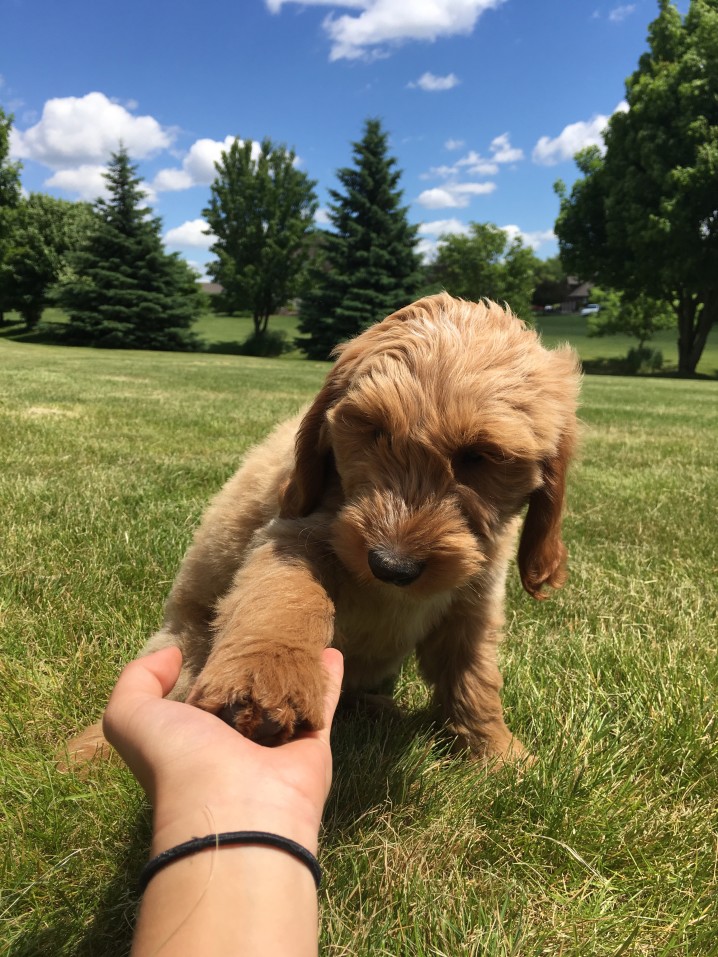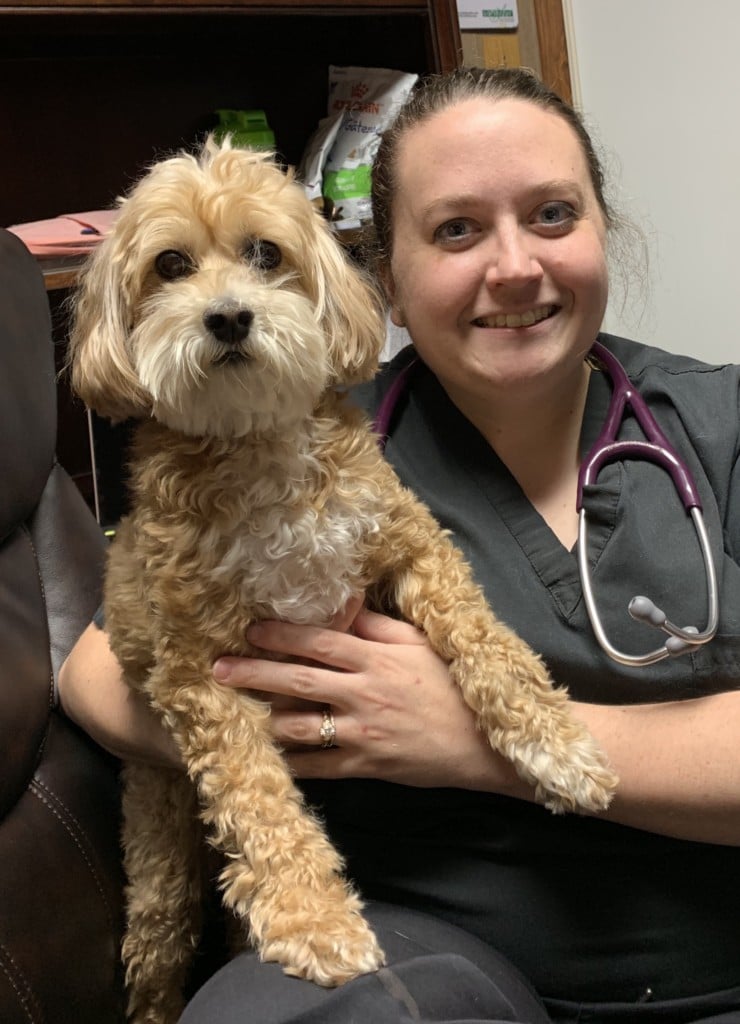7 Reasons Your Goldendoodle Is Limping and How to Fix It! (Veterinarian Explained!)
Did you Goldendoodle just come inside from playing outside, and they are limping? They may have just gotten up from their nap, and you are noticing that they are limping.
Or this may have been something that you have noticed, but it is gradually getting worse. There are numerous reasons that your Goldendoodle may be limping, some of these are very serious, and some are not so bad.
This article will explain many different reasons that your Goldendoodle may be limping and what you can do to help your pup quickly recover.

Why is my dog limping?
- Broken Leg
- Torn ACL
- Arthritis
- Something Stuck in their paw
- Broken Toenail
- Hip Dysplasia
- Elbow Dysplasia
Causes of Limping in Dogs and Goldendoodles
There are many reasons that your dog may be limping. These are some of the most common reasons that your dog would be limping.
Broken Leg
A broken leg is probably one of the most obvious causes of limping in your dog.
There are many reasons that your Goldendoodle may have broken their leg, such as gotten hit by a car or gotten their leg caught in something in the back yard or has a bone disease that causes their bones to be very brittle and easily break.

Most of the time, you can see where the leg is broken, and sometimes you can see the broken bone sticking threw the skin.
Some breaks are not as obvious as your dog may have just chipped a small piece of bone off the side of the limb.
Common signs seen with a dog with a broken leg are:
- Swollen leg
- Bruised leg
- Limping
- Crying in pain
If you think that your dog’s leg is broken, it is best to take them to your vet as soon as possible.
Your veterinarian will thoroughly examine your dog and take x-rays of your dog’s leg to confirm that it is broken. Your Goldendoodle may have to have surgery to fix the break. This will all depend on where your dog’s leg is broken and the severity of the break.
Sometimes your dog can wear a cast for a few weeks until the bones heal. Many times, casts cause more problems as you must keep them clean and dry.
Torn ACL
A torn ACL is commonly seen in medium to large breed dogs. The ACL is a ligament in the knee that helps keep the leg stabilized when walking.
A classic sign for a torn ACL is sudden limping shortly after exercise. Most dogs that are diagnosed with an ACL tear are very active dogs.
These tears will happen while they are playing, and when your dog comes back inside, they are limping. Many times, these dogs will not be putting any weight on their back leg at all.
If your dog is suddenly limping or not putting any weight on their leg, it is best to see your vet. The only way to fix an ACL tear is with surgery.
But there are many options to help decrease the pain that is causing your dog to limp while they are waiting for surgery.
Arthritis
As your dog ages, they will develop arthritis. This is a buildup of extra bone in and around the joints. The joints most commonly affected are hips, knees, and elbows.
If your dog is limping on one of their leg’s you can carefully move the different joints in that leg. If they do have arthritis developing, you can feel the crepitus as you move the joint.
There are many things you can do to help decrease the pain associated with arthritis. Things such as Non-Steroid Anti-Inflammatory Drugs (NSAIDs), Glucosamine, or other joint supplements will help keep your dog from limping as much.
Something Stuck in their Paw
Your Goldendoodle may have stepped on something and now has something stuck in their paw. Every time they put weight on their paw, it will hurt.
This causes them to limp. Common things found stuck in paws are rocks, thorns, or sticks. You can closely examine your dog’s paw and see if there is something stuck between their toes.

Many times your pet will also be licking on their paw if there is something stuck in there. If you cannot find anything, take your dog to the veterinarian. They can help look for something stuck.
Many times, a thorn can be very hard to find but will cause your dog a lot of pain when they are walking.
Broken Toenail
Some dogs may get a toenail caught in a blanket or rug. When they go to move, they will break their toenail. Many times, this break exposes the quick causing the toe to bleed.
Once the bleeding stops, your dog may limp for a few days because the toe is painful. This is similar to you breaking one of your fingernails. It usually hurt the first day or so and slowly gets better as the nail starts to grow back out.
If your dog only partially broke their toenail, they may need to see a vet. The vet will trim the rest of the nail and stop it from bleeding. This would keep the toe from hurting as bad. Sometimes a broken toenail will never grow back.
Hip Dysplasia
Hip dysplasia is commonly seen in large breed dogs. This is when their hips do not form correctly, causing the hips to not stay in the socket.
The movement of the hips in the joint socket can cause an increase in bony growth, leading to arthritis formation. If your Goldendoodle develops arthritis, they will usually limp.
Common signs of hip dysplasia are:
- Pain when trying to sit or stand
- Limping
- Painful when touching hips
- Abnormal gait
If you notice any of these symptoms, see your veterinarian. They will want to take x-rays of your dog’s hips to see if they do have hip dysplasia and the severity of their condition.
Many times, your vet will give your dog pain medication to help decrease the inflammation in the hip joints giving your pet relief. You can help decrease the chance of hip dysplasia by asking breeders about the parent’s medical background and picking a puppy from a litter with parents without hip dysplasia.
In an extreme case, your dog may need surgery. Veterinary Surgeons can do a total hip replacement, just like people have done. This will remove any pain caused by your Goldendoodle’s hip dysplasia.
Elbow Dysplasia
Elbow dysplasia is caused by one of three different problems. These are:
- Fragment medial coronoid process of the elbow,
- Osteochondritis of the medial humeral condyle and
- Ununited anconeal process.
In simpler terms, this an abnormal growth development of the cartilage and bone that is found in the elbow. The extra bone growth can cause the elbow to become displaced or out of its correct place.
This can cause the elbow joint to develop abnormally, leading to a life of pain, inflammation, and arthritis in the elbow.
Goldendoodles with elbow dysplasia may have no outward signs at all but can be so severe that they are not putting any weight on their leg. There are many treatment options to help decrease the pain and inflammation if your dog does develop elbow dysplasia.

When do I need to take my Goldendoodle to the vet?
If your Goldendoodle has just started limping and you cannot find an obvious source of the limping, waiting a few days before taking them to a vet is okay.
If your dog has obvious trauma to their legs, bruising, bleeding, or not able to walk at all, you need to see your vet as soon as possible—many causes for limping need to be addressed in the first 24 hours for a successful outcome.
If your Goldendoodle’s limping is progressively getting worse, you need to see your veterinarian.
Do not give any over the counter human pain medications as many of these are very toxic to dogs with even just a little dosage. Your veterinarian can prescribe your dog pain medications.
Common pain medication used to treat a dog that is limping is:
- Carprofen
- Meloxicam
- Gabapentin
- Tramadol
- Steroids
Your vet will give you instructions on how often to give your dog this medication. Make sure that your dog does eat when taking this medication so that you do not cause any GI problems.
What Can I Do at home for my Goldendoodle that is limping?
There are many at-home treatments that you can do for your Goldendoodle to help your dog recover from the injury that they are facing. Many times, the treatment for limping is rest and relax.
Just like with people, if your Goldendoodle is limping, decrease the amount of exercise and let them relax. Do not let your Goldendoodle run around in the back yard. Take them out on a leash to potty and bring them right back inside to rest.
Over the counter, joint supplements work great for mild cases of arthritis and limping in dogs. I highly recommend this supplement:
You should never give your Goldendoodle any medication intended for people. This could cause a lot of other issues with dogs. Your Goldendoodle cannot break down human medications the same way that we can. This causes a buildup of these medications in their body, leading to toxic levels very fast.
If you want to give your dog any human medications, it is best to consult your veterinarian first in order to not cause any other problems for your Goldendoodle

Helping Your Limping Goldendoodle
If your Goldendoodle is limping, there are many possibilities for the cause of this limping. Sometimes it may be extremely obvious to why your dog is limping while others are not so obvious.
Your veterinarian can examine your dog and take x-rays to help determine why your dog is limping. Depending on the cause, your veterinarian will prescribe pain medication, joint supplements, muscle relaxers, or physical therapy to help your dog return to their normal happy, and healthy life.
